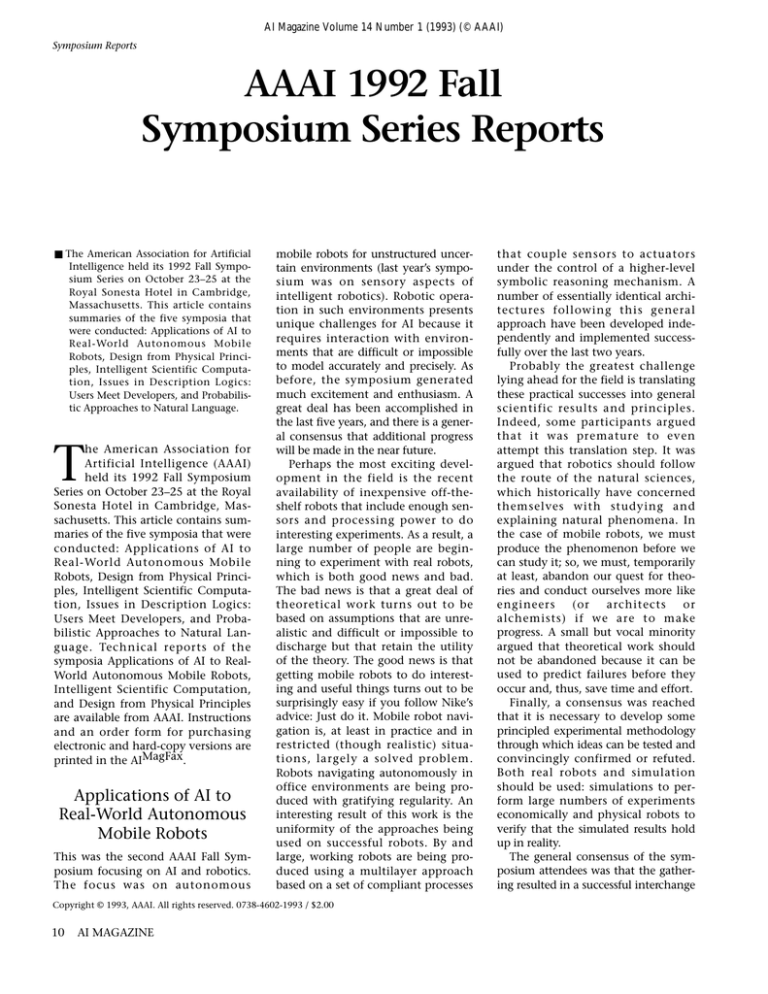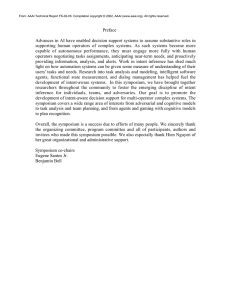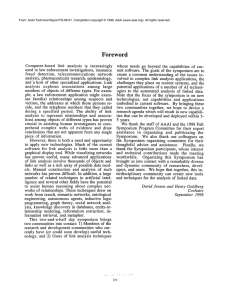
AI Magazine Volume 14 Number 1 (1993) (© AAAI)
Symposium Reports
AAAI 1992 Fall
Symposium Series Reports
■ The American Association for Artificial
Intelligence held its 1992 Fall Symposium Series on October 23–25 at the
Royal Sonesta Hotel in Cambridge,
Massachusetts. This article contains
summaries of the five symposia that
were conducted: Applications of AI to
Real-World Autonomous Mobile
Robots, Design from Physical Principles, Intelligent Scientific Computation, Issues in Description Logics:
Users Meet Developers, and Probabilistic Approaches to Natural Language.
T
he American Association for
Artificial Intelligence (AAAI)
held its 1992 Fall Symposium
Series on October 23–25 at the Royal
Sonesta Hotel in Cambridge, Massachusetts. This article contains summaries of the five symposia that were
conducted: Applications of AI to
Real-World Autonomous Mobile
Robots, Design from Physical Principles, Intelligent Scientific Computation, Issues in Description Logics:
Users Meet Developers, and Probabilistic Approaches to Natural Language. Technical reports of the
symposia Applications of AI to RealWorld Autonomous Mobile Robots,
Intelligent Scientific Computation,
and Design from Physical Principles
are available from AAAI. Instructions
and an order form for purchasing
electronic and hard-copy versions are
printed in the AIMagFax.
Applications of AI to
Real-World Autonomous
Mobile Robots
This was the second AAAI Fall Symposium focusing on AI and robotics.
The focus was on autonomous
mobile robots for unstructured uncertain environments (last year’s symposium was on sensory aspects of
intelligent robotics). Robotic operation in such environments presents
unique challenges for AI because it
requires interaction with environments that are difficult or impossible
to model accurately and precisely. As
before, the symposium generated
much excitement and enthusiasm. A
great deal has been accomplished in
the last five years, and there is a general consensus that additional progress
will be made in the near future.
Perhaps the most exciting development in the field is the recent
availability of inexpensive off-theshelf robots that include enough sensors and processing power to do
interesting experiments. As a result, a
large number of people are beginning to experiment with real robots,
which is both good news and bad.
The bad news is that a great deal of
theoretical work turns out to be
based on assumptions that are unrealistic and difficult or impossible to
discharge but that retain the utility
of the theory. The good news is that
getting mobile robots to do interesting and useful things turns out to be
surprisingly easy if you follow Nike’s
advice: Just do it. Mobile robot navigation is, at least in practice and in
restricted (though realistic) situations, largely a solved problem.
Robots navigating autonomously in
office environments are being produced with gratifying regularity. An
interesting result of this work is the
uniformity of the approaches being
used on successful robots. By and
large, working robots are being produced using a multilayer approach
based on a set of compliant processes
Copyright © 1993, AAAI. All rights reserved. 0738-4602-1993 / $2.00
10
AI MAGAZINE
that couple sensors to actuators
under the control of a higher-level
symbolic reasoning mechanism. A
number of essentially identical architectures following this general
approach have been developed independently and implemented successfully over the last two years.
Probably the greatest challenge
lying ahead for the field is translating
these practical successes into general
scientific results and principles.
Indeed, some participants argued
that it was premature to even
attempt this translation step. It was
argued that robotics should follow
the route of the natural sciences,
which historically have concerned
themselves with studying and
explaining natural phenomena. In
the case of mobile robots, we must
produce the phenomenon before we
can study it; so, we must, temporarily
at least, abandon our quest for theories and conduct ourselves more like
engineers
(or
architects
or
alchemists) if we are to make
progress. A small but vocal minority
argued that theoretical work should
not be abandoned because it can be
used to predict failures before they
occur and, thus, save time and effort.
Finally, a consensus was reached
that it is necessary to develop some
principled experimental methodology
through which ideas can be tested and
convincingly confirmed or refuted.
Both real robots and simulation
should be used: simulations to perform large numbers of experiments
economically and physical robots to
verify that the simulated results hold
up in reality.
The general consensus of the symposium attendees was that the gathering resulted in a successful interchange
Symposium Reports
of ideas. We want to hold another
symposium, at which we hope to
address some of the wider concerns of
the AI community as they relate to the
design of intelligent robots.
Erann Gat
Jet Propulsion Laboratory
California Institute of Technology
Marc Slack
MITRE Corporation
Avi Kak
Purdue University
Steve Chien
Jet Propulsion Laboratory
California Institute of Technology
Design from
Physical Principles
Design is a complex human activity
that requires a model of the surrounding environment and a way to
reason about the behavior of devices
embedded within this environment.
The Design from Physical Principles
Symposium focused on the use and
representation of skills from mathematics, physics, and engineering in
the design of physical artifacts and
processes. The objective of the symposium was to bring together
researchers from a diverse set of areas
with a common interest in design
from physical principles. These areas
included modeling, dynamics, qualitative, temporal, geometric, and terminological reasoning; planning;
diagnosis; learning; automated
deduction; and many aspects of traditional engineering design. Design
provided researchers with a common
focus to communicate their ideas,
combine their techniques, and evaluate their progress.
The symposium was organized
around the different stages of the
design process, which can roughly be
characterized as a generate-evaluatemodify cycle. Given a set of specifications and constraints, generative
design produces a candidate design.
To evaluate the candidate design, one
or more models capturing the properties of interest are generated. Simulation and analysis are then
performed to further evaluate the
candidate design and identify potential conflicts. Based on the results of
the evaluation, the design is modified or adapted, and the evaluation
cycle is repeated. At the symposium,
specific approaches addressing one or
more stages were proposed. They
mainly differed in the type of artifacts designed (plans, lumped-parameter systems, devices) and the
representation methods used (discrete events, ODES, PDES, and so
on). A separate session was devoted
to design in planning and control.
To gain some perspective on the
field, we organized two sessions to
examine both past and cur rent
design research projects. These projects included the Massachusetts
Institute of Technology (MIT) designer’s apprentice; the Rutgers University Ship Design Project; the Stanford
University How Things Work Project;
and broad efforts from University of
California at Berkeley, Cornell University, and Carnegie Mellon University. Two keynote addresses were
presented by G. Sussman and W. J.
Mitchell, both from MIT. Sussman’s
talk emphasized the use of sophisticated qualitative analysis of nonlinear dynamic systems in design.
Mitchell showed how shape grammars can be used to capture the form
and function of buildings and
devices. To give the workshop participants a practical flavor of design
from physical principles, we organized a design project based on a
realistic problem—the design of actuators for a self-adapting mirror at the
Lawrence Livermore National Laboratory. Participants worked on the
problem during the workshop in
mixed teams of engineers and computer scientists and presented their
results at the end.
The workshop was successful in
bringing together researchers from
various disciplines and having them
express their differing perspectives.
Although some areas, such as modeling, analysis, and optimization, have
made substantial progress, other
more encompassing areas, such as
design generation and adaptation,
are still in their infancies. The most
resounding theme of the symposium
was the crucial role that realistic
design scenarios play in exposing
important research problems.
Leo Joskowicz
IBM T.J. Watson Research Center
Brian Williams
XEROX Palo Alto Research Center
Jon Cagan
Carnegie Mellon University
Tom Dean
Brown University
Intelligent Scientific
Computation
The style of scientific computing is
poised for a change. Traditionally
specified in FORTRAN by the practicing
scientist or engineer, scientific computations are becoming more complex
because parallel architectures enable
increasingly ambitious simulations.
The application of AI techniques can
free mathematical modelers from
tedious programming tasks and enable
them to carry out more complex simulations and analyses.
The purpose of this first symposium on intelligent scientific computation was to identify the scope of
contributions that AI has made and
might make to scientific computing
and vice versa. The workshop participants’ collective background was a
good mix of AI and practical application experience, with many individuals having experience in both. The
applications discussed at the symposium ranged from fluid dynamics and
particle accelerators to yacht design
to the analysis of AI programs themselves. These are difficult problems
that challenge the AI community to
demonstrate its maturity. A wide
range of AI techniques have been
applied. For example, backwar d
chaining and abstraction were used
to formulate mathematical models;
expert systems and program synthesis
were used to select or generate codes
to solve the models numerically. A
novel method for accessing trade-offs
among selection criteria was presented. Other reasoning techniques
included assumption maintenance to
track approximations made and their
dependence on problem characteristics or efficiency trade-offs, spatial
reasoning to generate the grids over
which approximations are applied,
and qualitative reasoning and learn-
SPRING 1993
11
Symposium Reports
1993 Conference on
Artificial Intelligence in
Petroleum Exploration and Production
May 19 – 21, 1993
Dallas, Texas
For Conference Information:
(214) 754-6384 (voice)
(214) 754-3016 (fax)
In cooperation with AAAI
ing that help in data analysis. Much
scientific knowledge is represented
mathematically and procedurally,
with the need for a language that
combines mathematical and programming constructs. Object-oriented
representations
and
transformation rules are also important representation techniques.
Although the presentations typically focused on successful applications of existing AI technology, the
discussion periods addressed problems and possible research directions. For example, although
symbolic algebraic systems are powerful tools used by many of the participants, they need to be augmented
to include representations for multiple solutions and assumptions made
by the system. The importance of
12
AI MAGAZINE
validating solutions was stressed, and
a desire for better spatial reasoning
techniques was expressed. Although
there were a few examples of systems
that discovered new scientific results,
a certain lack of boldness in ambition was noted. Finally, the workshop participants discussed the
possibilities for shared representations of specifications and
knowledge bases. The problem of
applying AI techniques to scientific
computation is too hard to solve
without collaboration.
Elaine Kant
Schlumberger Laboratory for Computer Science
Richard Keller
NASA Ames Research Center
Stanly Steinberg
University of New Mexico
Issues in Description
Logics: Users
Meet Developers
The typical knowledge representation
system is like an iceberg—most of it is
hidden from view. Its internal architecture is invisible to its users as well
as to the AI literature. Thus, the recent
symposium on description logic systems provided a valuable setting for
bringing together users and developers to discuss their particular brand of
knowledge representation system.
A description logic (also known as
a KL-ONE–like language or a taxonomic logic) is a subset of first-order logic
whose expressivity has been restricted to the point where competent and
reasonably efficient deductive inference is possible. Alternatively, we
might characterize a description logic
as a funny representation language
that has no variables. For example, a
typical description logic might define
the concept of mother as follows:
(defconcept Mother (and Woman
(atleast 1 child))) .
This concept states that a mother is a
woman who has at least one child. A
description logic system is designed to
reason with such descriptions and
with term definitions that bind concept names to descriptions. A description classifier organizes a set of
descriptions into a taxonomy that is
ordered by subsumption relationships
computed between descriptions.
Description logics represent an
active area of current knowledge representation research; the 1992
Knowledge Representation Conference devoted three sessions to papers
on description logics. One reason for
this interest is that many description
logics have attractive theoretical
properties. Perhaps a better reason
for interest in description logics is
that a description classifier turns out
to deliver useful inferences that are
needed by real applications. This
symposium occurred at a point that
might represent a transformation in
the evolution of description logic
technology. Description logics are
now considered to be well understood, and many implementers are
beginning to broaden their horizons
with respect to the kinds of knowl-
Symposium Reports
edge representation issues that they
are willing to tackle. Here, we highlight some of the issues that were
discussed at the workshop.
Eric Mays
IBM T.J. Watson Research Center
Part-Whole Relations: Description
logic researchers have beaten the is-a
link into submission. Their next goal
might be to formalize inheritance
relations for part-whole links.
Tom Russ
USC/Information Sciences Institute
Expressivity: In the absence of
completeness as a natural boundary
on the expressiveness of a description logic, no one was able to identify theoretically based criteria for
determining how expressive a
description logic should be. However, this lack of criteria no longer
appears to be a deterrent for most
implementers of incomplete description logic systems.
Scaling Up: Some researchers discussed plans to apply their systems
to knowledge bases containing more
than 100,000 facts or more than
100,000 concepts. Scaling up to this
size will likely require new technological developments.
Default Logic: A number of efforts
are now under way to combine a
description logic with some form of
default logic. Because these efforts
represent ways to actually use default
logics rather than just talk about
using them, we hope to see concrete
progress in this area.
Planning: Many planning systems
construct and reason with plan taxonomies. Because description logic
systems are proficient at computing
taxonomic relationships, several
researchers have combined the two
technologies, using a description
classifier to construct a plan taxonomy.
Prepared presentations occupied
only a third of each workshop session, with the remaining time
reserved for brief position statements
and open discussion. The participants agreed that this format worked
extremely well—discussions were for
the most part lively, and the workshop proved to be a good medium
for exposing both current thinking
and future directions for description
logic systems.
Robert MacGregor
USC/Information Sciences Institute
14
AI MAGAZINE
Deborah McGuinness
AT&T Bell Laboratories
Probabilistic Approaches
to Natural Language
The symposium on probabilistic
approaches to natural language was
concerned with the use of probability theory for knowledge acquisition
and uncertainty management in natural language processing, in particular, the acquisition of linguistic
knowledge in assembling resources
such as lexicons and grammars.
Uncertainty management arises in
the need to evaluate and choose
between different interpretations of
texts.
During the symposium, reports
were presented on work addressing
problems such as tagging words with
parts of speech using statistical
methods and learning grammars
from corpora and word-sense disambiguation (determining intended
sense of a particular word in a text).
Statistical methods have recently
become useful in attacking these
problems because of the availability
of large online corpora (on the order
of millions of words and still rising)
and other machine-readable linguistic resources such as dictionaries and
thesauri.
Work on the use of subjective
(Bayesian) methods for uncertainty
management in natural language
processing was also discussed. These
methods were in the minority, and
despite interest in doing so, it was
difficult to see how to tie them to
statistical methods.
To get a
sense of the difficulty of the problems that were addressed, Bill Gale
pointed out that after 40 years of
work on the problem of word-sense
disambiguation, researchers still do
not have a clear definition of the
problem or even a clear sense of
what the senses are to choose from.
Nevertheless, a number of conclusions can be drawn based on the
work presented in the sessions. Some
of the least controversial of these
conclusions were the following:
First, simple statistical methods
work much better than more intricate, more brittle rule-based systems.
For example, consider the problem of
tagging words with parts of speech.
Just picking the a priori most likely
tag for each word, one seems to get
about 90-percent accuracy. Bi- and
tri-gram models get over 95-percent
accuracy, arguably as good as human
performance on this task.
Second, at least currently, there is a
distinction between language modeling for prediction (for example, for
speech recognition) and interpretation. It is not clear whether this distinction will persist.
Third, one must not undervalue
the importance of the words themselves when trying to capture facts
about language. Such information is
often lost when one abstracts to talk
about phrase markers. This statement
seems to be a partial explanation for
the failure of many parsers and the
somewhat disappointing results in
learning grammars from text. Yves
Schabes (Mitsubishi Research Labs)
and John Lafferty (IBM T.J. Watson
Research Center) presented various
methods for “lexicalizing” grammars
that hold promise for overcoming
this problem.
Conversely, though, there is a real
need for appropriate abstractions to
allow us to manage the immense
parameter spaces needed for stochastic models of language. This need is
all the more essential because of
Zipf’s Law. Zipf’s Law states that
much of the weight of the probability distributions we care about is in
the tails, making the number of trials
necessary to thoroughly sample prohibitively large, even given the
resources that are now becoming
available.
Robert P. Goldman
Tulane University
Eugene Charniak
Brown University
William A. Gale
AT&T Bell Laboratories
Peter Norvig
Sun Microsystems Laboratories



